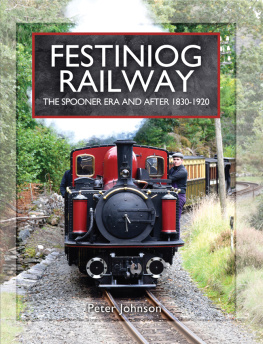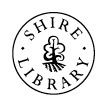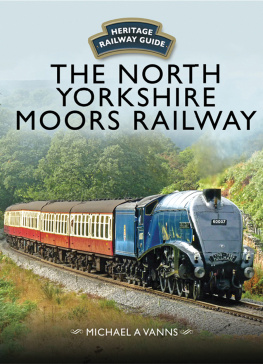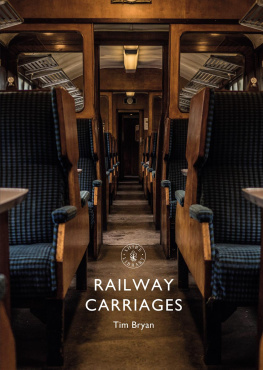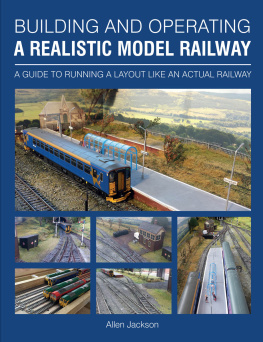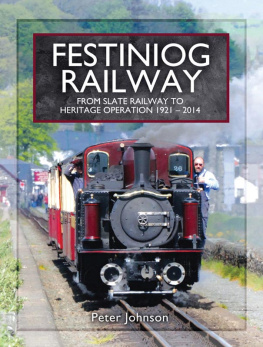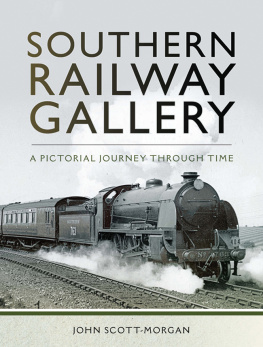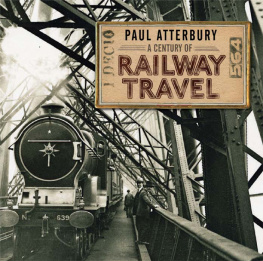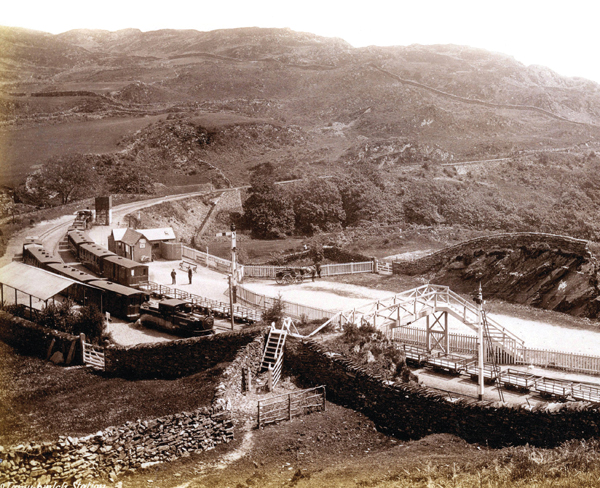
FESTINIOG RAILWAY
THE SPOONER ERA AND AFTER 1830-1920
FESTINIOG RAILWAY
THE SPOONER ERA AND AFTER 1830-1920
Peter Johnson
First published in Great Britain in 2017 by
Pen & Sword Transport
An imprint of Pen & Sword Books Ltd
47 Church Street, Barnsley, South Yorkshire S70 2AS
Copyright Peter Johnson 2017
The right of Peter Johnson to be identified as the author of this work has been asserted by him in accordance with the Copyright, Designs and Patents Act 1988. All rights reserved. No part of this publication may be reproduced or transmitted in any form or by any means, electronic or mechanical, including photocopy, recording or any information storage and retrieval system, without the prior written permission of the publisher, nor by way of trade or otherwise shall it be lent, re-sold, hired out or otherwise circulated without the publishers prior consent in any form of binding or cover other than that in which it is published and without a similar condition including this condition being imposed on the subsequent purchaser.
ISBN 978 1 47382 728 8
eISBN 978 1 47386 988 2
Mobi ISBN 978 1 47386 987 5
Pen & Sword Books Ltd incorporates the imprints of Pen & Sword Archaeology, Atlas, Aviation, Battleground, Discovery, Family History, History, Maritime, Military, Naval, Politics, Railways, Select, Social History, Transport, True Crime, and Claymore Press, Frontline Books, Leo Cooper, Praetorian Press, Remember When, Seaforth Publishing and Wharncliffe.
For a complete list of Pen & Sword titles please contact
Pen & Sword Books Limited
47 Church Street, Barnsley, South Yorkshire S70 2AS England
E-mail:
Website: www.pen-and-sword.co.uk
Design and typesetting
by Juliet Arthur, www.stimula.co.uk
Front Cover
Although it entered service in 1992, the appearance of bogie engine David Lloyd George is sympathetic to the Festiniog Railway's Victorian heyday, particularly when coupled with a train of vintage carriages.
Endpapers
This plan of the Festiniog Railway and its connections and feeders was produced in connection with the 1869 Act of Parliament.
Title Page
A classic scene at Tan y Bwlch c1890, the Festiniog Railway in its heyday. Bringing up the rear of the down train is the hearse van, adapted from an old quarrymens carriage in 1885.
ACKNOWLEDGEMENTS AND SOURCES
T here have been other books published about the Festiniog Railway; I have contributed several since 1986. Here, the story from the 1830s is revisited, drawing mostly on original and/or contemporary sources.
I wish to extend my sincere thanks to these friends and colleagues for their ongoing support and encouragement and/or assistance with this book: Michael Bishop, Tim Edmonds, Adrian Gray, Alan Heywood, Paul Ingham, Peter Jarvis, Richard Kirk, Paul Lewin, Roderick Low, Stephen Murfitt, Gordon Rushton, Mark Stephenson, Andrew Stephen Thomas, Geoff and Patricia Ward, John Wooden.
Re-use of known photographs in a book like this is unavoidable. Where possible, priority was given to material that has not been published recently. In some cases, it has been possible to use better prints than those published before.
Except where noted photographs are from my collection, created over many years. Recent additions have been obtained via the well-known vendor to the nobility, auction website eBay; regrettably the originators of many of these are unknown.
The Festiniog Railway Company is blessed with a remarkable archive which, whilst not complete and not providing all the answers, does contain a vast amount covering the railways operations from its earliest years. Deposited at Gwynedd Council's archive section at Caernarfon, it has been catalogued most assiduously by Patricia Layzell-Ward and on public access since 2011. The catalogue itself is a great asset and in many cases permits documents to be referenced without viewing. Archive assistant Giles Maurice was diligent in photocopying many documents for me.
The one constant in this book is the words of the companys directors, in their reports to shareholders and in their minutes. The former date from 1844. The whereabouts of the first minute book, covering the period up to the 1869 Act of Parliament, is not known. Those covering the period up to 1939 were deposited with Gwynedd Councils archives section in the 1980s. At the same time that they were deposited the companys archivist, the late Michael Seymour, had them copied onto microfilm which I had scanned a few years ago.
Also deposited at Caernarfon with the minutes were the locomotive repair books covering the period from 1875 until 1914, which were also microfilmed. Once again I had the microfilm scanned, enabling me to make much use of this valuable resource.
At the National Archives, the Board of Trade and Ministry of Transport records were re-examined. The British Telecom Archive in London holds information regarding the companys telephone network.
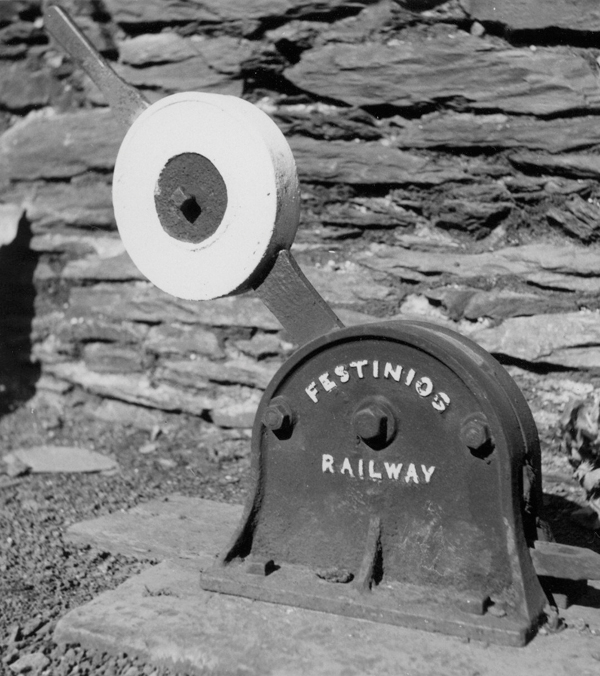
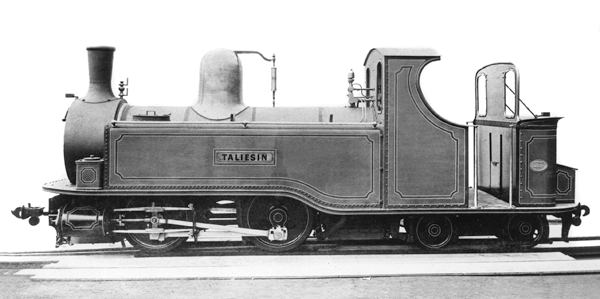
A works photograph of the single Fairlie Taliesin , built to G. P. Spooners design at the Vulcan Foundry in 1876. The couplings were removed before the loco entered service.
Plans and other parliamentary records were viewed at the Parliamentary Archives in the House of Lords. Copies of Acts of Parliament were viewed at the National Archives and the University of Leicester Library. The journals of both houses of Parliament were also seen at the latter. Google Books provided access to accounts of the activities of the court of referees on private bills held in university libraries in the USA.
Newspapers in the British Newspaper Archive and Welsh Newspapers Online collections were of considerable use. Together, they have provided many new insights into the railway and its operations dating back to its construction from 1833. As might be expected from newspapers, they also provide insights into people who worked for the railway or who were affected by it in some other manner.
Other printed sources accessed online were the technical journals Engineering and The Engineer, held by Graces Guide to British Industrial History. The Gazette , formerly the London Gazette , is the default site for Parliamentary and other public notices.
Some use has been made of census and other data available on the Ancestry genealogical website and of wills supplied by the Probate Service.
Even for someone familiar with the Ffestiniog Railways story, compiling this book has been quite an adventure, leading me down many unexpected avenues and to the discovery of new insights. There is so much material available that it is not possible to cover every aspect of the railway's history, but it has certainly been possible to capture the essence of it.
Unless stated otherwise, all opinions are mine; they do not represent the views of the Festiniog Railway Company or any of the associated bodies. It must be emphasised that I am responsible for any errors.

